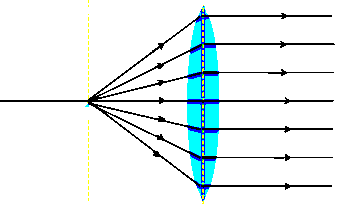
If the central portion of a convex lens is wrapped in black paper as shown in the figure:

(A) No image will be formed by the remaining portion of the lens.
(B) The full image will be formed but it will be less bright.
(C) The central portion of the image will be missing.
(D) There will be two images each produced by one of the exposed portions of the lens.
Answer
217.5k+ views
Hint: The black paper covered region blocks some light rays entering. This makes a slight difference in the intensity. It reduces the brightness of the image more than usual. So the image formed is complete but less bright.
Complete step-by-step answer:

The light beam passing through the lens undergoes refraction and forms an image on the other side of the lens. When the central part of the lens is covered with black paper it avoids the light ray passing through it to some extent but not completely. As a large number of rays are passing through the lens only a small percentage of the rays are cut off. It does not make any difference in the size and shape of the image. But since small values of light rays are blocked the intensity of the image is slightly reduced than the normal refraction.
Hence, the correct option is B.
Note: The image formed by a convex lens is real and inverted or virtual and erect depending on the position of the object. The image formed by the concave lens on the other hand is always virtual and erect regardless of the position of the object.
Complete step-by-step answer:

The light beam passing through the lens undergoes refraction and forms an image on the other side of the lens. When the central part of the lens is covered with black paper it avoids the light ray passing through it to some extent but not completely. As a large number of rays are passing through the lens only a small percentage of the rays are cut off. It does not make any difference in the size and shape of the image. But since small values of light rays are blocked the intensity of the image is slightly reduced than the normal refraction.
Hence, the correct option is B.
Note: The image formed by a convex lens is real and inverted or virtual and erect depending on the position of the object. The image formed by the concave lens on the other hand is always virtual and erect regardless of the position of the object.
Recently Updated Pages
Addition of Three Vectors: Methods & Examples

Addition of Vectors: Simple Guide for Students

Algebra Made Easy: Step-by-Step Guide for Students

Relations and Functions: Complete Guide for Students

Analytical Method of Vector Addition Explained Simply

Arithmetic, Geometric & Harmonic Progressions Explained

Trending doubts
JEE Main 2026: Application Form Open, Exam Dates, Syllabus, Eligibility & Question Papers

Derivation of Equation of Trajectory Explained for Students

Hybridisation in Chemistry – Concept, Types & Applications

Understanding the Angle of Deviation in a Prism

Understanding Collisions: Types and Examples for Students

How to Convert a Galvanometer into an Ammeter or Voltmeter

Other Pages
JEE Advanced Marks vs Ranks 2025: Understanding Category-wise Qualifying Marks and Previous Year Cut-offs

Understanding Atomic Structure for Beginners

Ideal and Non-Ideal Solutions Explained for Class 12 Chemistry

Degree of Dissociation: Meaning, Formula, Calculation & Uses

Understanding Electromagnetic Waves and Their Importance

Understanding the Electric Field of a Uniformly Charged Ring




